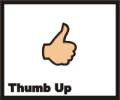
This is the basic thumbs-up gesture. This should not be used for the normal "okay" or "yes" as observers too easily figure this out.
Most
teams have a very effective verbal communications system. They often times use
codes to relay information to one another. However, there are times when, even
though the opposing teams may not be aware of your codes, shouting the codes
WILL make them aware that you are up to something. Sometimes, there are
situations where you simply do not wish to make any verbal sign at all.
That's
where hand signals come it.
The
key is not too have too many different hand signals (which makes them hard to
remember) but still had enough to cover most of your codes. This system
addresses both problems by using very easy to remember signals and variations.
Also the signals are all ONE-HANDED as the most you'll ever have in the game is
one free hand, unless your team routinely goes onto the field without markers.
Teams
who specialize in scenario games could also use these signals. Often times, as
they will attest, verbal communication is not tactically sound.
Remember
that these signals are limited; they can only be used when you have a direct
line of sight to a fellow teammate. However they have the advantage that in most
situations, only your team will be aware codes are being used. It is a lot
easier for someone on the sidelines to associate a verbal code with the
subsequent actions of your team. If they don't see the hand signal, to them the
player/s in question simply acted on their own.
As
an aside, you can even substitute your own hand forms the Basic Signals. Instead
of a thumbs up, you can show a fist with your small finger extended, etc.
This
system does not have to represent ALL your team codes (although it conceivably could).
You could decide that only those codes most frequently used could have hand
signals.
The
system is comprised of 6 Basic Signals, 2 Up/Down Variations (for
each basic) and 4 Motion Modifiers (for each Basic and Variation).
You
can then use each Basic Signal with no motion, add 2 Up/Down Variations and then
add the four Motion Modifiers.
If
you use the Basic Signals AND the Up/Down Variations AND the Motion
Modifiers you'll have almost sixty different signals.

This is the basic thumbs-up gesture. This should not be used for the normal
"okay" or "yes" as observers too easily figure this out.
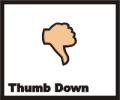
This is the basic thumbs-down gesture. This should not be used for the normal
"negative" or "no" as this is too easily figured out by
observers.
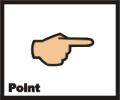
This means to either go this direction, cover this direction, or if followed by
pointing at their eyes, watch this direction.
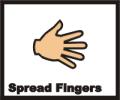
This means to go right (if shown back of hand), or go left (if shown palm of
hand).
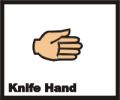
Same as above, but except of going right, you are flanking the right position,
or vice versa.
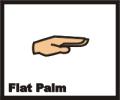
Keep low, crawl if possible.
NOTE:
You maybe wondering why there isn't a similar sign with the palm up. It is not
included as it is difficult to apply a Down Variation. After you read the Down
Variations description hold you palm face up and try and do a Down Modifier on
the signal and you'll see what I mean.
For
these you can either present the signal with the hand in it's up or down
position . . .
. . . or . . .
. . . first display the Basic
Signal and then move the hand up or down.
 Keep close
Keep close
 Follow Five seconds after, to either side, palm means left, back hand means
right side
Follow Five seconds after, to either side, palm means left, back hand means
right side
 Follow
Five sec. after, Flank right or left. Use knife hand as variation.
Follow
Five sec. after, Flank right or left. Use knife hand as variation.
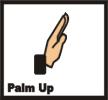 follow standing and to the side. If pinky finger is shown, stay right, and thumb
stay left.
follow standing and to the side. If pinky finger is shown, stay right, and thumb
stay left.
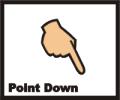 Hold
this position
Hold
this position
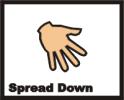 Follow
immediately, then hold position until signaled again, to either side, palm means
left, back hand means right side
Follow
immediately, then hold position until signaled again, to either side, palm means
left, back hand means right side
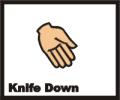 Follow
Five sec. after, Flank right or left. Use knife hand as variation. But crawling
Follow
Five sec. after, Flank right or left. Use knife hand as variation. But crawling
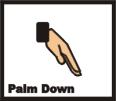 follow immediately, crawling and to the side.
If pinky finger is shown, stay right, and thumb stay left.
follow immediately, crawling and to the side.
If pinky finger is shown, stay right, and thumb stay left.
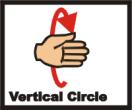
Followers of signal Rotate Position
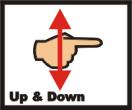 last
member takes point. Point takes last position
last
member takes point. Point takes last position
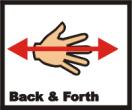 Same
as up & down, but right flanker moves to left, and left to right.
Same
as up & down, but right flanker moves to left, and left to right.
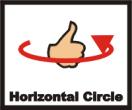 All
retreat to closest bunker. Except Signaler
All
retreat to closest bunker. Except Signaler
Learn these before any tourney, and make sure you remember them, they will be reviewed in practices, but not all will be used each time.
All
of the articles in the website Durty Dan's Paintball Information Services are
free to use for webpages, school projects, reference and to promote paintball to
players and the non-playing public. Credit for the source of the information
should be included in the bibliography or references page.
© Durty Dan Enterprises 2000. All rights reserved. All works contained herein
are under copyright of the author Durty Dan. While the Terms of Use are broad
they do not include the right to republish this work in any publication
(hardcopy or electronic) for the purposes of personal financial gain.